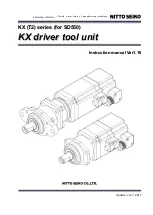
If the motor starts oscillating at a certain speed, increase
parameter 1-14 Damping Gain
. Increase the value in small
steps. Depending on the motor, this parameter can be set
to 10–100% higher than the default value.
Application-specific adjustment when running flux
Flux control principle is the preferred control principle for
optimum shaft performance in dynamic applications.
Perform an AMA because this control mode requires
precise motor data. Depending on the application, further
adjustments may be required.
See
chapter 5.4.3 Asynchronous Motor Set-up
for application-
specific recommendations.
5.4.5 SynRM Motor Set-up with VVC
+
This section describes how to set up a SynRM motor with
VVC
+
.
NOTICE
The SmartStart wizard covers the basic configuration of
SynRM motors.
Initial programming steps
To activate SynRM motor operation, select
[5] Sync.
Reluctance
in
parameter 1-10 Motor Construction
.
Programming motor data
After performing the initial programming steps, the SynRM
motor-related parameters in parameter groups
1-2* Motor
Data
,
1-3* Adv. Motor Data
, and
1-4* Adv. Motor Data II
are
active. Use the motor nameplate data and the motor
datasheet to programme the following parameters in the
order listed:
1.
Parameter 1-23 Motor Frequency
.
2.
Parameter 1-24 Motor Current
.
3.
Parameter 1-25 Motor Nominal Speed
.
4.
Parameter 1-26 Motor Cont. Rated Torque
.
Run a complete AMA using
parameter 1-29 Automatic
Motor Adaptation (AMA)
[1] Enable Complete AMA
or enter
the following parameters manually:
1.
Parameter 1-30 Stator Resistance (Rs)
.
2.
Parameter 1-37 d-axis Inductance (Ld)
.
3.
Parameter 1-44 d-axis Inductance Sat. (LdSat)
.
4.
Parameter 1-45 q-axis Inductance Sat. (LqSat)
.
5.
Parameter 1-48 Inductance Sat. Point
.
Application-specific adjustments
Start the motor at nominal speed. If the application does
not run well, check the VVC
+
SynRM settings.
provides application-specific recommendations:
Application
Settings
Low-inertia applications
I
Load
/I
Motor
<5
Increase
parameter 1-17 Voltage filter
time const.
by factor 5–10.
Reduce
parameter 1-14 Damping
Gain
.
Reduce
parameter 1-66 Min. Current
at Low Speed
(<100%).
Low-inertia applications
50>I
Load
/I
Motor
>5
Keep the default values.
High-inertia applications
I
Load
/I
Motor
>50
Increase
parameter 1-14 Damping
Gain
,
parameter 1-15 Low Speed Filter
Time Const.
, and
parameter 1-16 High
Speed Filter Time Const.
High-load at low speed
<30% (rated speed)
Increase
parameter 1-17 Voltage filter
time const.
Increase
parameter 1-66 Min. Current
at Low Speed
to adjust the starting
torque. 100% current provides
nominal torque as starting torque.
This parameter is independent of
parameter 30-20 High Starting Torque
Time [s]
and
parameter 30-21 High
Starting Torque Current [%]
). Working
at a current level higher than 100%
for a prolonged time can cause the
motor to overheat.
Dynamic applications
Increase
parameter 14-41 AEO
Minimum Magnetisation
for highly
dynamic applications. Adjusting
parameter 14-41 AEO Minimum
Magnetisation
ensures a good
balance between energy efficiency
and dynamics. Adjust
parameter 14-42 Minimum AEO
Frequency
to specify the minimum
frequency at which the frequency
converter should use minimum
magnetisation.
Motor sizes less than 18
kW
Avoid short ramp-down times.
Table 5.8 Recommendations for Various Applications
If the motor starts oscillating at a certain speed, increase
parameter 1-14 Damping Gain
. Increase the damping gain
value in small steps. Depending on the motor, this
parameter can be set to 10–100% higher than the default
value.
Commissioning
VLT
®
AutomationDrive FC 301/302
28
Danfoss A/S © 07/2015 All rights reserved.
MG33AQ02
5
5
Summary of Contents for VLT AutomationDrive FC 301
Page 2: ......
















































